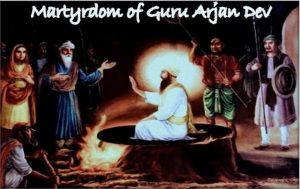Iqbal Singh Lalpura

The Sikh religion began in 1469 with the birth of Guru Nanak Dev Ji, a spiritual light who rejected hollow rituals as the path to God. Guru Nanak proclaimed that the human body itself is the true temple of the Divine. To light the lamp of the soul, one must live truthfully, follow the guidance of the Guru and the scriptures, and engage in service to humanity. Meditation and prayer are the tools for enlightenment. Guru Nanak’s mission was to transform ordinary human beings into beings of higher consciousness — angels in human form:
“Balhari Gur Aapne Deohari Sad Vaar
Jin Manas Te Devte Kiye, Kart Na Lagi Vaar.”
Another foundation of his teaching was equality:
“Jano Jot Na Puchho Jati, Aage Jat Na Hai.”
For over two centuries, ten Gurus preached the same message, culminating in 1708 AD. Guru Gobind Singh Ji, the tenth Guru, infused the Sikh spirit with martial strength, transforming his followers into the Khalsa — the army of the Almighty — with the divine mission to protect humanity and uphold righteousness. Guru Nanak preached that life without honour is worthless:
“Je Jive Pat Lathi Jai, Sab Haram Jeta Kichh Khae.”
And for honour, one must be ready to sacrifice life itself:
“Jo Tou Prem Khelan Ka Chau,
Sir Dhar Tali Gali Meri Aao.”
Equality and Courage as the Foundations of Sikhism
From the very beginning, the Sikh Gurus eliminated social distinctions:
“Manas Ki Jaat Sabhe Eko Pahchanbo.”
They rejected caste barriers, championed equality, and urged their followers to live with honour and self-respect. This message of human dignity appealed to both Hindus and Muslims of the time. Guru Nanak Dev Ji came to be lovingly remembered as “Jahar Peer, Jagat Guru Baba” — the spiritual guide of the world.
But the courage to speak truth to power often came at a high cost. The contemporary rulers felt threatened by the growing influence of the Gurus. Guru Arjan Dev Ji, the fifth Guru, was martyred in 1606 for preaching this Gospel of Angels, to the annoyance of the Mughal Emperor Jahangir. Later, Guru Tegh Bahadur Ji, the ninth Guru, laid down his life in 1675 to protect the right to freedom of religion — not for his own faith, but for the Kashmiri Hindus who faced forced conversion. In that era, his sacrifice was unparalleled in the world.
Khalsa Rule and its Legacy
After Guru Gobind Singh Ji’s passing, the Khalsa rose to power under Baba Banda Singh Bahadur, establishing rule in 1710 — just two years after the Guru left for his heavenly abode. Although Banda Singh’s rule was short-lived, by the late 18th century, the Khalsa had conquered Delhi and later, under Maharaja Ranjit Singh, established a kingdom spanning from the Khyber Pass to Tibet. This empire was larger than England at the time — prosperous, just, and committed to religious harmony.
During his lifetime, Guru Nanak Dev Ji travelled extensively, covering much of Asia, including Mecca, Madina, Sri Lanka, Iran, Afghanistan, China, and the length and breadth of India. He engaged with religious leaders of various faiths, many of whom accepted his philosophy and became his followers. Similarly, Guru Tegh Bahadur Ji travelled widely across India, blessing countless communities and planting seeds of spiritual awareness.
Decline of Propagation After the British Takeover
The middle of the 19th century saw the fall of the Sikh empire. The British annexed the Khalsa Kingdom of Lahore in 1849. Before this, the Gurus had established organised systems for spreading Sikh teachings through Manjis and Masands, which ensured continuous learning and preaching.
However, with the loss of sovereignty and the British control over historical Gurdwaras, the active propagation of Sikhism diminished sharply. Gurdwara management committees, formed under colonial-era laws, gradually became stepping stones to political power. Today, these committees are often controlled by political parties. Sadly, religious preaching no longer appears high on their agenda.
In many places, the noble mission of prachar (preaching) has shifted from being a selfless service to becoming a source of livelihood. New Gurdwaras are frequently built, yet without parallel efforts to make them centres of learning and spiritual training, they remain underutilised as instruments of transformation. Expenditure on research, history, and philosophical study is minimal, despite the vast heritage of Sikh thought.
The Global Sikh Presence — A Missed Opportunity
Over the past century, four to five million Sikhs have settled abroad — in North America, Africa, Europe, and Australia. While these communities have achieved considerable economic success, their primary focus has been livelihood, not religious propagation. A major challenge is the language barrier — many preachers lack command over the local languages, which limits their ability to communicate Sikh philosophy effectively. Moreover, there is an absence of dedicated Sikh research and training centres in foreign countries.
The global Sikh diaspora represents an untapped potential for spreading Guru Nanak’s universal message. Just as Guru Nanak Ji engaged with the world, our modern presence across continents could be a platform for global outreach — if channelled with vision and unity.

The 350th Martyrdom Anniversary of Guru Tegh Bahadur Ji
In November 2025, Sikhs will commemorate the 350th martyrdom anniversary of Sri Guru Tegh Bahadur Ji. This is not just a historical milestone, but the right time to reintroduce the Sikh message to the world.
Guru Tegh Bahadur’s martyrdom for the defence of another community’s religious freedom is a story of moral courage that resonates far beyond Sikhism. In today’s world, where intolerance and persecution still exist, his life offers a universal lesson: the defence of another’s rights is the highest form of faith.
We must ask ourselves — can we use this occasion to launch a renewed movement for the promotion and propagation of Sikhism? Can we tell the world about the Guru who gave his life for the right to religion, centuries before human rights became a global ideal?
Imagine if, across countries, Sikh communities organised exhibitions, lectures, and publications in local languages detailing Guru Tegh Bahadur’s life, Sikh philosophy, and way of life. Imagine distributing this material not only among Sikhs, but also among neighbours and friends of other faiths.
A Call for Unity and Organisation
To make this vision a reality, we must address internal weaknesses. Can we stop the infighting and public defamation of fellow Sikhs, especially during such sacred commemorations? The world cannot take our message seriously if we ourselves are divided.
We could also collaborate with non-governmental organisations (NGOs) that work in interfaith dialogue, human rights, and education. Such partnerships could amplify our reach. Equally, we can approach local governments to support events that showcase the Sikh contribution to universal values.
A key initiative could be the creation of a group of 350 respected Sikh achievers from various walks of life — scholars, artists, soldiers, entrepreneurs, and community leaders — who would commit to promoting Sikh values globally in honour of Guru Tegh Bahadur’s 350th martyrdom anniversary. This symbolic group could spearhead events, media outreach, and community engagement.
From Celebration to Continuous Effort
While the anniversary in 2025 provides a strong focal point, our efforts should not be limited to one year. We need a long-term plan to establish Sikh study centres, both in Punjab and abroad, where Sikh philosophy can be studied, researched, and taught in multiple languages. We must invest in training young Sikhs — men and women — to become effective communicators of Guru Nanak’s vision.
Technology, too, must be harnessed. Digital platforms can carry Sikh teachings into homes and hearts across the globe. Online courses, interactive apps, podcasts, and translated scripture can connect with audiences far beyond our physical reach.
Seizing the Moment
Sikhism was born with a message for all humanity — a message of equality, truth, courage, and service. Guru Nanak Dev Ji walked across continents to share it. Guru Tegh Bahadur Ji laid down his life to defend its principles. The Khalsa built kingdoms on these ideals and protected the oppressed.
History has shown us that Sikhism flourishes when it actively engages with the world. Today, with millions of Sikhs living globally and modern communication at our fingertips, the potential to spread Guru Nanak’s light is greater than ever.
But potential alone is not enough. We must unite, plan, and act. We must train preachers who can speak in the world’s languages. We must build institutions that study and share Sikh philosophy. We must turn our Gurdwaras into beacons of learning, not merely places of ritual. Above all, we must live the values we preach — truth, humility, service, and fearlessness.
As we approach the 350th martyrdom anniversary of Guru Tegh Bahadur Ji, let us pray for the strength to rise to this occasion. Let us work together — across borders and differences — to tell the world about the Guru who gave his life so others could worship freely. Let us turn this commemoration into the beginning of a new chapter in Sikh history.
This is an appeal to every Sikh — wherever you live, whatever your profession — to join in the service of the Guru at this historic moment. Bring your time, your skills, your voice, and your resources to this sacred mission. Let us stand as one Khalsa Panth to spread the light of Guru Nanak and the courage of Guru Tegh Bahadur to the entire world.
The time is now. The opportunity is before us.
Let us begin this sacred work — for the honour of our Gurus and the service of humanity.
(The author is former Chairman, National Commission for Minorities, Government of India – 9780003333)